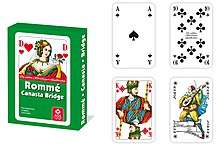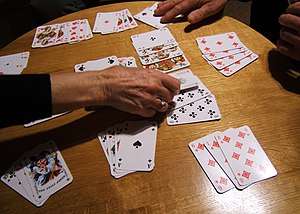German Rummy
German Rummy or Rommé (German: Deutsches Rommé or Rommé mit Auslegen) is the most popular form of the worldwide game, Rummy, played in Austria and Germany. It is a game for 2 to 6 players and is played with two packs of French playing cards, each comprising 52 cards and 3 jokers. There are no partnerships, every player plays for him- or herself. In Germany, the Germany Rummy Association (Deutscher Romméverband) is the umbrella organisation for local rummy clubs and organises national competitions. The game is often just known as Rommé in Germany and Rummy in Austria.
| Rommé | |
 A pack of 110 German Rummy cards | |
| Origin | Germany |
|---|---|
| Type | Matching |
| Players | 2–6 |
| Age range | All |
| Cards | 2 x 52 + 6 Jokers |
| Deck | French |
| Play | Clockwise |
| Card rank (highest first) | A K Q J 10 9 8 7 6 5 4 3 2 (A) |
| Playing time | 6-15 minutes/hand |
| Random chance | Medium |
| Related games | |
| Rummy, Viennese Rummy | |
Rules
The following rules largely follow Danyliuk and Grupp.[1][2]
Aim
The aim of Rommé is to organise one's hand into sets or runs known as 'figures' (Figuren) and to meld them by placing them on the table. The player who is first to meld all his cards, wins the game.
Preparation
Before the first hand begins, the cards are shuffled and laid face down in a arc. Each player draws one card; the player with the highest card selects his place and is the first dealer. The other players sit to the left of the dealer in the order of the rank of the cards drawn.
Dealing
The deal changes clockwise after each hand. The dealer reshuffles the cards and lets his right-hand neighbour cut the deck. The cards are dealt face down clockwise, each player is dealt thirteen cards in 3 packets of three and 1 packet of four. The remaining cards are placed face down in the middle of the table as a Stoß (i.e. a talon or stock, pronounced "shtowss") and the top card is turned and placed beside the stock to form the waste pile.
Variations: In many cases, the rule is that if a player finds a joker when cutting, he may keep it. This is known as robbing or plundering (rauben), not to be confused with the rule allowing a joker to be exchanged (see below). In some rules, the top card is not turned but the dealer (or forehand) receives a fourteenth card and is first to play. In this case they do not draw a card, but simply make their first meld if they can and discard a card to start the waste pile.
Figures
Figures (Figuren) are combinations of at least three cards as follows:
- Sets (Sätze) of 3 or 4 equal-ranking cards of different suits, such as ♥K–♦K–♣K or ♠3–♥3–♦3–♣3,
- Runs (Folgen, Reihen, Sequenzen) of 3 or more cards in suit and in sequence - Aces may be high or low; for example ♥A–♥2–♥3, ♦8–♦9–♦10–♦B or ♣D–♣K–♣A, but not ♠K–♠A–♠2.
Figures may be built with the aid of Jokers. Jokers are wild cards which may be used to represent any other card; for example ♣B–♣D–J–♣A or ♠6–♥6–J.
A figure may not be built with just one natural card and two Jokers; in a run of at least four cards, however, two Jokers may follow one another so, for example ♠3–J–J–♠6 is an allowed combination.
Card values
The card values are as follows:[3]
- Court cards – King, Queen and Jack – 10 points each
- Pip cards – 2 to 10 – score their value in pips
- Ace (Ass)
- 11 points in a set or run after the King
- 11 points at the end of the game
- 1 point when used first in a run A-2-3.
- Joker
- during the game - as many points as the card it represents
- 30 points at the end of the game
Playing
The dealer is the first player to go. He may now meld figures, provided he meets the requirement for the first meld and ends his turn by placing a card face-up next to the pile ("discards"). Then it is the turn of the player to his left.
Each following player begins his or her play by picking up either:
- the card turned up by his predecessor
- the topmost face-down card of the Stoß
After that, a player may meld cards and finish his turn by placing a card face up on the discard pile.
Sometimes the game is played in such a way that a player may only pick up the top card of the discard pile if he plays it immediately in a meld, either by using the card for his first meld - in this case it counts towards the required 40 points (see below) - or by using it in another meld.
First meld
For the first meld by each player, the cards being melded must have a value of at least 40 points (but see variants). Players may not 'lay off' cards onto existing melds when making their first meld.
Subsequent melds
Once a player has placed his first meld, he may, when it is his turn, play additional melds at any time; their point value is only relevant for the first meld, not subsequent ones.
Lay-offs
Once a player has made his first meld, he may at any time, when it is his turn, lay off individual cards to melds already made, regardless of whether the meld was made by the player or one of his opponents.
Example: On the table is ♥2-♥3-♥4. If a player holds ♥ A and ♥ 5 in his hand, he may lay off two cards to the melded sequence.
Once melded, cards may no longer be returned to the hand or discarded.
Swapping a Joker

If there a figure with a Joker on the table, for example ♠6-♥6-J, and if a player holds the card that is represented by the Joker, here the ♣6 or ♦6, he can swap the Joker for this card. The Joker must be immediately used in a new meld and not just added to the player's hand. A Joker may only be swapped out after the first meld has been made.
The rules of the German Skat Association are stricter on this point: according to their rules, a Joker may only be replaced in a set if the set is completed with four cards of the same rank.[4]
Ending
The player who is first to get rid of all his cards by melding and/or laying off and, if need be, placing his last card face down (verdeckt) on the discard pile, while announcing "Rommé" - to signify the end of the game - wins the game. All the remaining players receive as many minus points as they have card points in their hand.
Differences from Basic Rummy
The main differences between German Rummy and Basic Rummy (according to Parlett) are:
- German Rummy uses 2 decks and 6 Jokers, as opposed to one deck and 2 Jokers
- Players are dealt an initial hand of 13 cards as opposed to 7 or 10
- Players must score at least 40 points on the first meld
German Rummy is very similar in these respects to the Italian variant, Scala Quaranta.[5]
See also
References
- Danyliuk 2017, p. 149-152.
- Grupp & 1975/79, pp. 58-60.
- Danyliuk 2017, p. 151.
- Rummy Rules of the German Skat Association (pdf; 72 kB)
- Parlett 2008, p. 494.
Literature
- _ (1988) Erweitertes Spielregelbüchlein aus Altenburg, 8th edition, Verlag Altenburger Spielkartenfabrik, Leipzig, pp. 168-172.
- Babsch, Fritz (1983). Internationale und österreichische Kartenspiel-Regeln, Piatnik, Vienna.
- Bamberger, Johannes (2011). Die beliebtesten Kartenspiele, Perlen-Reihe Vol. 648, 25th edition, Verlag Perlen-Reihe, Vienna, pp. 127-133. ISBN 978-3-99006-002-5
- Danyliuk, Rita (2017). 1x1 der Kartenspiele, 19th ed., Humboldt, Hanover. ISBN 978-3-86910-367-9
- Grupp, Claus D (1975/1979). Karten-spiele, Falken, Niederhausen. ISBN 3-8068-2001-5
- Grupp, Claus D. (1982). Rommé und Canasta in allen Variationen, Falken-Verlag Niedernhausen/Ts.
- Heinrich, Rudolf [d. i. Rudolf Bretschneider]: Rommé - Rummy international Alle Spielarten, Verlag Perlen-Reihe, Vol. 650, 7th edition, Vienna, 19??
- Kopp, Dr. Bernhard (1987). Die schönsten Kartenspiele, Buch und Zeit Verlag, Wiesbaden, pp. 46-48. ISBN 3-8166-9570-1
- Lembke, Robert E. (1974?). Das große Haus- und Familienbuch der Spiele. Lingen, Cologne, pp. 207-211.
- Parlett, David (2008). The Penguin Book of Card Games, Penguin, London. ISBN 978-0-141-03787-5
- Smith-Creighton, John (1927). Das Rummyspiel, 3rd edition, Vienna.
External links
- Internationale Rommé-Ordnung des DSkV (International Rommé Rules by German Skat Association). (in German)
- Rommé Rules of German Rummy at www.spielanleitung.org.
(in German)
- Regelwerk Rules to download from the German Rommé Association.
| Look up de:Rommé in Wiktionary, the free dictionary. |